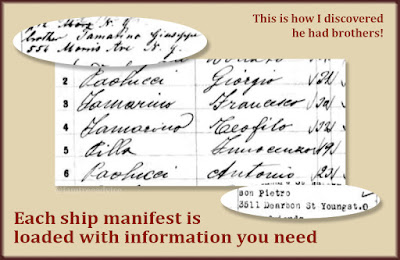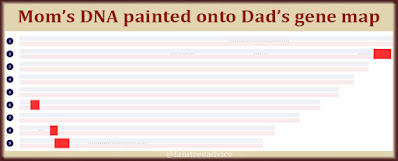His repeated trips to America give me lots of clues about my great grandfather's life.
My great grandfather Francesco Iamarino made a handful of trips from Italy to the Bronx where his brother lived. He set out on his first trip in 1903. He was 25 years old with a wife and infant son (my grandfather).
 |
| Did your ancestor make more than one trip to another country? |
His brother, my 2nd great uncle Giuseppe, left for America in 1900. Francesco stayed behind and married a year later. Giuseppe Iamarino stayed in the Bronx. My dad remembers living in Uncle Joe's apartment building as a child.
But my great grandfather Francesco did not stay. He was what they call a "bird of passage". That's an immigrant who left the poverty of Italy in the late 19th and early 20th centuries to earn money. They made multiple journeys across the ocean. They found work, earned money for a period of time, and went back home to their wives and children.
My other ancestors came to America to stay. But not Francesco.
His ship manifests are the only evidence I have of his time in America. He was not here for a census. He's not in a city directory. He's only on the ship manifests.
 |
| Without all his trips, I'd have nothing but birth, marriage, and death records. |
Here are some of the facts I've pieced together:
- July 11, 1903. Francesco leaves his wife Libera and my 9-month-old grandfather Pietro to sail to New York.
- August 1, 1903. Francesco arrives in the New York harbor to join his brother Giuseppe at 556 Morris Avenue in the Bronx. Coincidentally, this is the same neighborhood where my mother's family lived. They'd arrived in 1899.
- February 21, 1904. Francesco's 2nd child Giovannangela is born, but it isn't clear if Francesco is in Italy at the time.
- February 24, 1909. After the birth of his 3rd child, Maria, Francesco returns to the Bronx and his brother, Giuseppe. This time he travels with 4 other men from his hometown. One is his brother Teofilo; the others are his brothers-in-law.
- 13 October 1913. Once again, Francesco returns to his brother in the Bronx.
- 10 September 1922. Francesco's 4th and final child Assunta is born. Francesco is 44 years old, but isn't quite done making those 3-week voyages across the Atlantic.
- 19 March 1929. Did Francesco know this was to be his final trip to America? This time he went to Youngstown, Ohio, to visit the son he hadn't seen in almost a decade. He meets his son's wife and new baby girl.
 |
| Multiple voyages mean more and more facts for your family tree. |
Francesco's many voyages shaped him and changed him. On one of his trips, staying in the Bronx, he heard singing and stopped into a local church. It was an Evangelical Church—not the Catholic Church of his traditional Italian upbringing.
My great grandfather was so moved by what he saw, he became a convert. He saw people overcome by the spirit of God. They were wailing and crying. Back home in Italy, Francesco founded his own small church. His grandchildren and great grandchildren are still running the church today. They're the ones who told me this story and showed me their church.
Imagine how different his and his family's lives would have been if he hadn't made that particular trip to the Bronx.
Are you looking for your ancestors who didn't stay in your country? You may have a bird of passage in your tree and not even know it.
And speaking of our immigrant ancestors:














